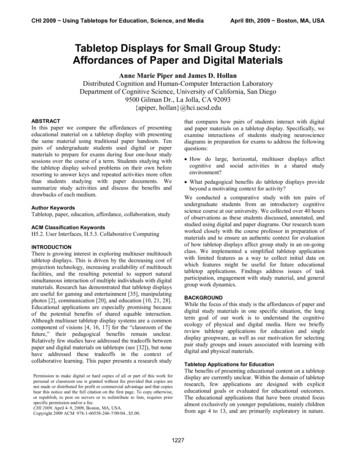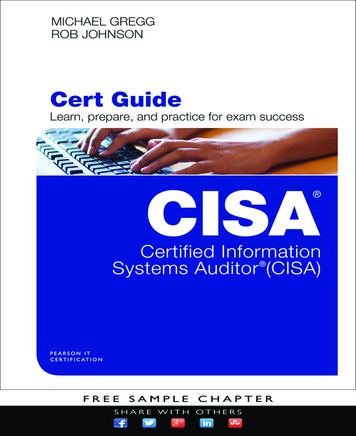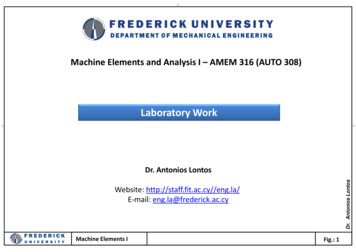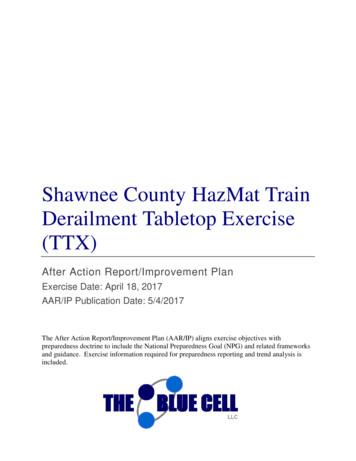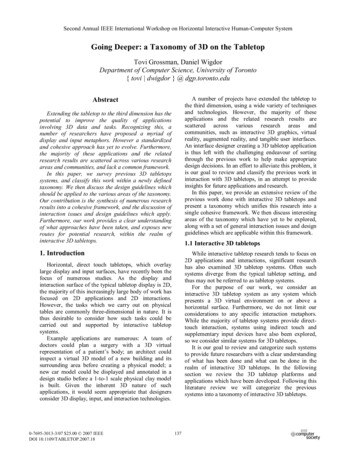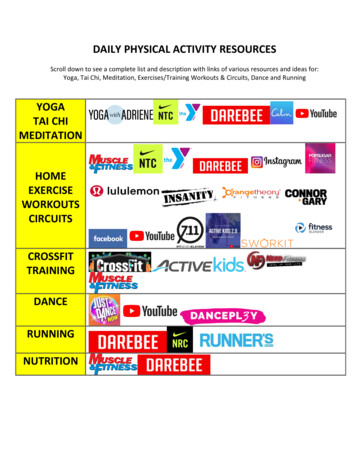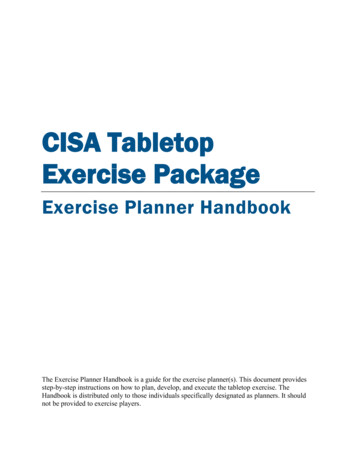
Transcription
CISA TabletopExercise PackageExercise Planner HandbookThe Exercise Planner Handbook is a guide for the exercise planner(s). This document providesstep-by-step instructions on how to plan, develop, and execute the tabletop exercise. TheHandbook is distributed only to those individuals specifically designated as planners. It shouldnot be provided to exercise players.
CISA Tabletop Exercise Package (CTEP)Exercise Planner HandbookThis page is intentionally left blank.Department of Homeland SecurityCybersecurity and Infrastructure Security AgencyExercise ONLY / Unclassified
CISA Tabletop Exercise Package (CTEP)Exercise Planner HandbookTable of ContentsThe Basics of a Tabletop Exercise .1General Characteristics .1Application.1Leadership .1Duration .114 Key Steps to a Successful Exercise .3Step 1: Review Documents .3Step 2: Identify the Exercise Planning Team.4Step 3: Hold a Concept and Objectives Meeting .5Step 4: Hold an Initial Planning Meeting .5Step 5: Exercise Development .6Step 6: Hold a Midterm Planning Meeting .6Step 7: Send the Invitation .7Step 8: Continue Exercise Development .8Step 9: Hold a Final Planning Meeting .8Step 10: Print Documents .9Step 11: Conduct the Exercise .9Step 12: Draft After-Action Report / Improvement Plan .11Step 13: After-Action Meeting .11Step 14: Finalize and Distribute the After-Action Report / Improvement Plan .11Appendix A: Adapting Tabletop Exercise Documents . A-1Core Capabilities. A-1Exercise Objectives. A-1Scenario . A-2Discussion Questions . A-2Agenda . A-3Situation Manual . A-3Exercise Brief Slide Deck . A-3Invitation Letter . A-4After-Action Report / Improvement Plan . A-4Appendix B: Tabletop Exercise Development Checklist. B-1Appendix C: Reference List .C-1Appendix D: Acronym List .D-1Table of ContentsiDepartment of Homeland SecurityCybersecurity and Infrastructure Security AgencyExercise ONLY / Unclassified
CISA Tabletop Exercise Package (CTEP)Exercise Planner HandbookThis page is intentionally left blank.Table of ContentsiiDepartment of Homeland SecurityCybersecurity and Infrastructure Security AgencyExercise ONLY / Unclassified
CISA Tabletop Exercise Package (CTEP)Exercise Planner HandbookTHE BASICS OF A TABLETOP EXERCISEA tabletop exercise (TTX) is a facilitated discussion of a scripted scenario in an informal, stressfree environment that is based on current applicable policies, plans, and procedures. The TTXdesign process facilitates conceptual understanding, identifies strengths and weaknesses, and/orachieves changes in policies and procedures. The success of the exercise depends largely ongroup participation in the identification of problem areas and the resolution of those problems.General CharacteristicsThe exercise begins with a general setting, which establishes the stage for the hypotheticalsituation. In your exercise, the facilitator stimulates discussion by intelligence or situationupdates. These updates describe major events that may be directed to individual players orparticipating departments, agencies, or organizations. Recipients of the updates then discuss theaction(s) they might take in response to the situation / incident.Finally, the facilitator utilizes key questions which focus on roles (how the players wouldrespond in a real situation), plans, coordination, the effect of decisions on other organizations,and similar concerns to drive the discussion.A TTX is focused on discussion of roles rather than simulation; equipment and resources do notdeploy during a TTX.ApplicationA TTX has several important applications: low stress discussion of coordination and policy thatestablishes a collaborative environment for problem solving; and providing an opportunity forkey agencies, organizations, and stakeholders to become acquainted with one another, theirinterdependencies, and their respective responsibilities.LeadershipA facilitator leads the exercise discussion, decides who gets a message or problem statement,calls on others to participate, asks questions, and guides the players toward sound decisions.ParticipationExercise planners should choose players carefully to adequately represent their discipline,agency, or organization. Players ideally should have the authority to speak on behalf of thestakeholders they represent.DurationThe agenda for each exercise template allows for four hours of exercise play; however, thelength is ultimately at your discretion. During the exercise, discussion times are open-ended, andplayers are encouraged to take their time in arriving at in-depth decisions without time pressure.The Basics of a Tabletop Exercise1Department of Homeland SecurityCybersecurity and Infrastructure Security AgencyExercise ONLY / Unclassified
CISA Tabletop Exercise Package (CTEP)Exercise Planner HandbookAlthough the facilitator maintains an awareness of the time allocated for each area of discussion,the group does not have to complete every item in order to meet the objectives or for the exerciseto be a success.The Basics of a Tabletop Exercise2Department of Homeland SecurityCybersecurity and Infrastructure Security AgencyExercise ONLY / Unclassified
CISA Tabletop Exercise Package (CTEP)Exercise Planner Handbook14 KEY STEPS TO A SUCCESSFUL EXERCISEEnclosed you will find instructions and templates to help you conduct an exercise that uses theU.S. Department of Homeland Security (DHS) Federal Emergency Management Agency(FEMA) Homeland Security Exercise and Evaluation Program (HSEEP) exercise guidance. Foradditional details regarding exercise design and execution, please refer to the HSEEP Doctrine.All recommended actions in this guide assume that you will begin planning at least threemonths before the desired exercise date.This section outlines the key actions that will be taken in the exercise planning process. For acomplete list of exercise tasks to be completed at each stage of the planning process, pleasereference Appendix B: Exercise Development Checklist.Step 1: Review Documents(Task should be accomplished three or more months prior to the actual exercise.)Below is a list of supporting exercise documents provided in your TTX: Welcome Letter – An official letter that describes the purpose of the CISA TabletopExercise Package (CTEP) and its content. Exercise Planner Handbook – This document provides a guide for the exercise planner.It gives step-by-step instructions on how to plan, develop, and execute TTXs using CTEPmaterials, as well as a list of various reference materials located in Appendix C:Reference List. Invitation Letter Template – A template of an official invitation letter that anorganization may send to the exercise participants (players and observers). Situation Manual (SitMan) – A manual that provides the scenario, supportingbackground information, and suggested discussion questions to be posed to the exerciseplayers. Throughout the exercise, players should be encouraged to use the manual to helpsupplement the information in the Exercise Brief Slide Deck and stimulate discussion. Exercise Brief Slide Deck Template – A template for a PowerPoint presentation used inconjunction with the SitMan that the exercise facilitator uses to guide players through thescenario, modules, and discussion questions. The template should be updated using theSitMan selected by the planner / planning team. Facilitator & Evaluator Handbook –This document provides the information neededby facilitators, evaluators, and data collectors. It supplements the SitMan with guidanceto assist in capturing information and feedback during the exercise for developing theAfter-Action Report/Improvement Plan (AAR / IP). Participant Feedback Form – A form that is mainly used to gather recommendationsand key outcomes from the exercise as well as feedback on the exercise design andconduct from the players.14 Key Steps to a Successful Exercise3Department of Homeland SecurityCybersecurity and Infrastructure Security AgencyExercise ONLY / Unclassified
CISA Tabletop Exercise Package (CTEP)Exercise Planner Handbook Exercise Planner Feedback Form – A feedback form used by the exercise planners andthe facilitator to consolidate players’ feedback on exercise improvement. AAR / IP Template – A template of an AAR / IP to aid the exercise planner andevaluators / data collectors in developing an HSEEP style AAR / IP.Step 2: Identify the Exercise Planning Team(Task should be accomplished three or more months prior to the exercise.)The exercise planning team (EPT) is vital to the success of any exercise. The planning team isresponsible for guiding the development process, obtaining the necessary venue and resources,and should be able to achieve buy-in from their organizations for the exercise. It is recommendedthat you think carefully about who should be on the planning team and attempt to keep the totalnumber of planning team members manageable. Think about the proposed scenario and exercisegoal described, identify those departments and agencies that would be involved in responding tothat scenario, and invite those representatives to be members. EPT members will be involved inthe details of exercise development and therefore should not be players in the exercise.Suggestions for planning team members to consider are:Internal: Owners / Management Operations and Maintenance Engineering Emergency Response Security Spokesperson / Public InformationOfficer Business Continuity Information Technology /CommunicationsExternal: Other members of your sector State / local fusion centers State / local Emergency OperationCenters State / local emergency managementagenciesDHS Cybersecurity andInfrastructure Security Agency –Protective Security Advisor (PSA) Regulating agencies State / local law enforcementagencies Other Federal partners International partners Key members of your supply chain Regional / State / local homelandsecurity / counterterrorism agencies14 Key Steps to a Successful Exercise4Department of Homeland SecurityCybersecurity and Infrastructure Security AgencyExercise ONLY / Unclassified
CISA Tabletop Exercise Package (CTEP)Exercise Planner HandbookStep 3: Hold a Concept and Objectives Meeting(Task should be accomplished three months prior to the exercise.)The Concept and Objectives (C&O) Meeting is the formal start to the exercise planning process.It helps planners determine the exercise program priorities to be addressed, design objectivesbased on those priorities, and identify EPT members. Expected outcomes of a C&O Meeting are: Confirmation of EPT members Agreement regarding exercise concept (scope, type, mission area[s], exercise programpriorities to be addressed), exercise objectives, and aligned core capabilities Exercise planning timeline, to include target exercise conduct time frame, withmilestones List of assigned tasks prior to the next planning meeting, to include reaching out toadditional planning team members and developing detailed exercise objectivesStep 4: Hold an Initial Planning Meeting(Task should be accomplished two and a half months prior to the exercise.)Note: The C&O and Initial Planning Meeting (IPM) can be combined to shorten the planningtimeline and be less burdensome resource-wise. Should the meetings be run concurrently, thetasks listed for both should be completed.The IPM serves to identify exercise design requirements, assumptions and artificialities, scenariovariables (e.g., time, location, hazard selection), and exercise logistics, such as exercise location,schedule, duration, participants, and other relevant details. Expected outcomes of the IPM are: Exercise scenario Clearly defined exercise objectives and aligned core capabilities Format of exercise (see below for discussion) Finalized exercise planning timeline with exercise conduct logistics Confirmation of expected level of effort for all participating organizations List of assigned tasks prior to the next planning meetingExercise formats for consideration: Plenary: In a plenary format, the players organize as a single group without regard forfunctional area grouping (e.g., owners, management, local representatives; facilitysecurity; engineering; law enforcement). This format requires only a single facilitator, aswell as one or two evaluator / data collectors; however, a co-facilitator may ease theburden of a single facilitator. This format is generally best for 25-30 players when thereare a limited number of people available to fill the roles of facilitator and evaluator / datacollector.14 Key Steps to a Successful Exercise5Department of Homeland SecurityCybersecurity and Infrastructure Security AgencyExercise ONLY / Unclassified
CISA Tabletop Exercise Package (CTEP)Exercise Planner Handbook Multi-Table: Under a multi-table format, there are multiple individual tables organizedby discipline, agency, organization, or functional area. First, a lead facilitator frames thescenario and poses discussion questions to all players. Group discussions occur at theindividual tables, ideally facilitated by someone with functional area expertise. Iffeasible, it is desirable to assign both a facilitator and an evaluator / data collector to eachgroup so that the facilitator can focus on addressing issues related to exercise objectives,while the evaluator / data collector focuses on capturing general discussion issues.Step 5: Exercise Development(Tasks should be accomplished prior to the Midterm Planning Meeting.)In this phase, members of the planning team should complete the assignments given during thefirst two planning meetings and continue to socialize and build support for the exercise withintheir own organization. Actions should include logistics necessary to secure a venue for theexercise date and developing a draft SitMan and Facilitator & Evaluator Handbook with theagreed upon objectives and core capabilities.Venue Logistics Make sure the room is large enough to accommodate all participants and observers and isaccessible to both internal and external invitees. It would be beneficial if the requiredspace was open the evening prior to the exercise to setup and work through any technicalissues. There should also be an area for the facilitator(s) and evaluator(s) / datacollector(s) to meet prior to and after the exercise. The room must also have adequate audio / video (A/V) capability in order to run yourpresentation. A room with adjustable lights is necessary for seeing the projector screen(s),and having at least two wireless microphones to pass around the room is recommended. It is always beneficial to book a backup room at another location in case of unforeseencancellations or other last-minute issues.Step 6: Hold a Midterm Planning Meeting (MPM)(Task should be accomplished six to eight weeks prior to the exercise.)The MPM is the opportunity to discuss exercise staffing and logistics, review the SitMan toinclude the proposed scenario and discussion questions, and determine the exercise invitationprocess.Exercise staffing: Facilitators. Facilitators provide situation updates and moderate discussions. They alsoprovide additional information or resolve questions as required. Key EPT members mayalso assist with facilitation as subject matter experts (SMEs) during the exercise. Theplanning team should identify a primary choice for facilitator during this planningmeeting and who should be responsible for confirming whether they can attend. Theplanning team should also identify table facilitators if using a multi-table format.14 Key Steps to a Successful Exercise6Department of Homeland SecurityCybersecurity and Infrastructure Security AgencyExercise ONLY / Unclassified
CISA Tabletop Exercise Package (CTEP)Exercise Planner Handbook Evaluators / Data Collectors. Evaluators and/or data collectors are assigned to observeand document certain objectives during the exercise. Their primary role is to documentplayer discussions, including how and if those discussions conform to plans, polices, andprocedures. The planning team should identify individuals with the skill sets or subjectmatter expertise to fill these functions. The planning should also identify one or moremembers of the planning team to collect the input from the evaluators / data collectorsfollowing the exercise and put it into a draft AAR / IP. Exercise Staff. Any exercise should have sufficient personnel to register participants,manage refreshments, support information technology, etc.Discussion questions: The discussion questions provided in the SitMan are suggested generalsubjects you may wish to address as the discussion progresses. These questions are not meant toconstitute a definitive list of concerns to be addressed. You should add, delete, or modify any ofthe discussion questions to most effectively address the objectives of your exercise and the needsof your organization. The final questions should be based upon the objectives for the exercise,and included in the SitMan.When determining what discussion questions to include, be sure to keep in mind the time frameallotted for each module, as well as for the overall exercise. It is also recommended the planningteam select half a dozen additional individual questions or sub-questions for the facilitator toaddress if a module is running ahead of schedule. These additional questions should be includedin the Facilitator and Evaluator Handbook in italics but should not be included in the SitMan.Logistics: At the MPM, the EPT should confirm exercise logistics, such as estimate ofparticipants, exercise schedule, and venue. It is highly recommended that refreshments beprovided. Depending on start and end times, that could include light snacks, breakfast, lunch, orall of the above. This will depend on resources, but experience has shown that exerciseparticipants are much more inclined to engage with exercise material if they are not hungry. TheEPT should determine at the MPM what refreshments, if any, will be provided, and who will beresponsible for providing them.Attendees: Players. Every exercise will have players. They are personnel who discuss their regularroles and responsibilities during the exercise. They describe what their response to thescenario would be, answer questions, and interact with the facilitator and other players.Players should be chosen carefully to adequately represent their discipline, agency, ororganization and must have the authority to speak on its behalf. Observers. Observers do not generally directly participate in the exercise; however, theymay ask relevant questions or provide subject matter expertise if called on by thefacilitator.Step 7: Send the Invitation(Task should be accomplished five to seven weeks prior to the exercise.)The invitation should come from your organization’s management in the form of either an emailor signed / scanned letter. The invitation should include the exact date, time, location, and14 Key Steps to a Successful Exercise7Department of Homeland SecurityCybersecurity and Infrastructure Security AgencyExercise ONLY / Unclassified
CISA Tabletop Exercise Package (CTEP)Exercise Planner Handbookduration of the exercise; directions to the facility; security / access requirements; and should statewhether food / refreshments will be provided. For your use, there is an invitation letter templateprovided.Be sure to address all staff and facility access requirements and other needs in the invitationletter. For example, the facility used for the exercise might require a “visitor request form.” Inthis case, you would ensure all external players fill out the form and return it to you or theappropriate office well before the exercise date. If special parking directions are required, youmust include that as well. You can explain the process in words or provide a map.Step 8: Continue Exercise Development(Task should be accomplished three to four weeks prior to the exercise.)The documents provided in the template will need minor adjustments to meet yourorganization’s needs. There are some sections where that need is obvious (e.g., organizationname) and others where it may require more in-depth changes. Any items that are changed inone of the products will most likely need to be changed throughout the entire package (e.g.,Facilitator and Evaluator Handbook, SitMan, and Exercise Brief Slide Deck). This is alsothe phase in which all of the discussion question modifications should be made. Please refer toAppendix A of this document for complete instructions on how to adapt all of the documents foryour needs. During this period, the documents should be made into as final a version as possible.These documents should be sent to the planning team for review prior to the Final PlanningMeeting.In addition to modifying the exercise documents, the planning team members should finalize anylogistical details and continue to build support for the upcoming exercise. Members of theplanning team should also confirm the facilitator(s), evaluators / data collectors, and exercisestaff during this period.Step 9: Hold a Final Planning Meeting (FPM)(Task should be accomplished two weeks prior to the exercise.)The FPM should focus on ensuring that all elements of the exercise are ready for conduct. Nomajor changes to the exercise’s design or scope should take place at or following the FPM. TheFPM ensures that all logistical requirements have been met, outstanding issues have beenidentified and resolved, and exercise products are ready for printing. Be sure to review thediscussion question sets in the SitMan and Facilitator & Evaluator Handbook, and the back-upquestions in the Facilitator & Evaluator Handbook to confirm the modifications made earlier inthe process. In summary, the following items should be addressed during the FPM: Conduct a comprehensive, final review of all exercise documents and presentationmaterials; Resolve any open exercise planning issues and identify last-minute concerns; and Review all exercise logistical activities (e.g., schedule, registration, attire, special needs).14 Key Steps to a Successful Exercise8Department of Homeland SecurityCybersecurity and Infrastructure Security AgencyExercise ONLY / Unclassified
CISA Tabletop Exercise Package (CTEP)Exercise Planner HandbookStep 10: Print Documents(Task should be accomplished one week prior to the exercise.)At a minimum, print one SitMan for each participant and a Facilitator & Evaluator Handbook foreach facilitator and evaluator / data collector. It is recommended, however, that you print abouttwenty percent more SitMans than the number of participants that you are expecting. Printing theExercise Brief Slide Deck and reference documents for each participant is at your discretion.Step 11: Conduct the ExerciseExercise conduct involves activities such as preparing for exercise play, managing exercise play(presentation, facilitation, and discussion), and conducting immediate exercise wrap-upactivities. Members of the EPT assigned to support exercise setup should visit the exercise site atleast one day prior to the event to arrange the room, test A/V equipment, and discussadministrative and logistical issues. On the day of the exercise, planning team members shouldarrive several hours before the start of the exercise to handle setup activities and arrange forregistration.The presentation typically starts with brief remarks by representatives from the EPT or otherhigh-profile individuals in attendance. After the opening remarks, the presentation moves into abrief introductory and explanatory phase led by a facilitator. During this phase, attendees will beintroduced to any other facilitators, given background on the exercise process, and advised abouttheir individual roles and responsibilities.The facilitator generally presents the multimedia briefing, which describes the scenario and anyrelevant background information. The facilitator also leads the discussion, poses questions to theaudience, and ensures that the schedule remains on track.In a plenary format, players are organized as a single group, without regard for functional areagrouping (e.g., owners, management, and local representatives; facility security; engineering;law enforcement). The facilitator(s) briefs the modules and moderates the questions for the entiregroup.Under a multi-table format, there are multiple individual tables organized by discipline, agency,organization, or functional area. A lead facilitator first frames the scenario and poses discussionquestions to all players. Group discussions occur at the individual tables, ideally facilitated bysomeone with subject matter expertise.After the breakout sessions take place, the entire group typically reconvenes to address any keyissues, cross-disciplinary issues, or conflicting recommendations that were identified duringgroup discussions. A player from each group briefs the key points of their discussions to thegroup at large. Under both formats, players should discuss their responses based on theirknowledge of current plans, procedures, and capabilities.In both formats, a facilitator is responsible for keeping the discussion focused on the exerciseobjectives and making sure all issues are explored within the time allotted. A good facilitatorshould possess:14 Key Steps to a Successful Exercise9Department of Homeland SecurityCybersecurity and Infrastructure Security AgencyExercise ONLY / Unclassified
CISA Tabletop Exercise Package (CTEP)Exercise Planner Handbook The ability to keep side conversations to a minimum, keep discussions on track andwithin established time limits, control group dynamics and strong personalities, andspeak competently and confidently about the subject without dominating conversation; Functional area expertise or experience; Awareness of appropriate plans and procedures; and The ability to listen well and summarize player discussions.If feasible and/or appropriate, co-facilitators who are knowledgeable about local issues, plans,and procedures may assist the lead facilitator. Also, designating a recorder to take notes allowsthe facilitator to focus on key discussion issues.Prior to the exercise, instruct the evaluators / data collectors to keep an accurate written record ofwhat is observed. To be reliable, they should take notes as players discuss actions, makedecisions, and discuss their capabilities during the exercise. Collect this information at theconclusion of the exercise as these notes will form the basis of the analysis for the AAR / IP. Atthe conclusion of the exercise, it is also beneficial for the after-action process to conduct a hotwash involving players. A hot wash allows players to self-assess and discuss their performancein the exercise. The hot wash also provides the evaluators / data collectors with the opportunityto clarify points or collect any missing information from the players before they leave theexercise.To supplement the information collected during the player hot wash, the evaluation teamdistributes participant feedback for
The Basics of a Tabletop Exercise 1 Department of Homeland Security . calls on others to participate, asks questions, and guides the players toward sound decisions. Participation . . Engineering Emergenc
